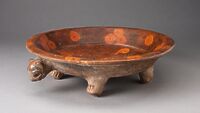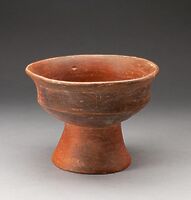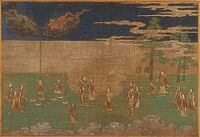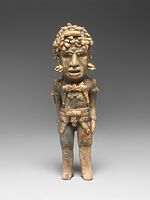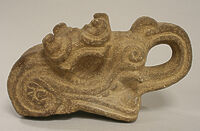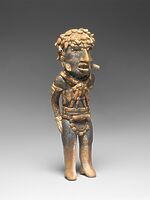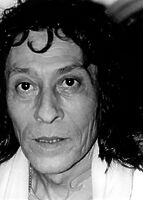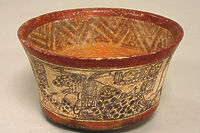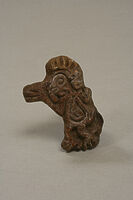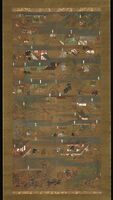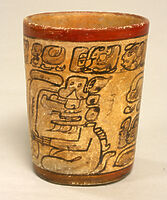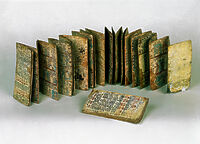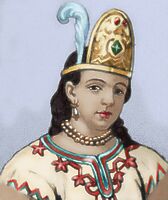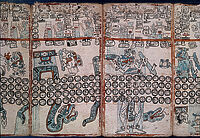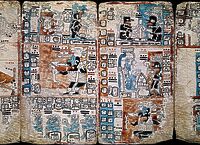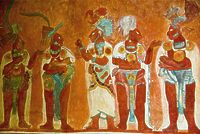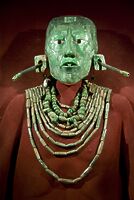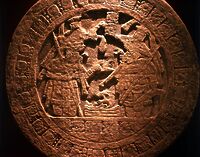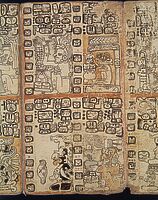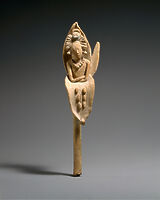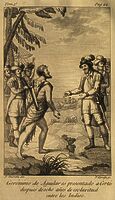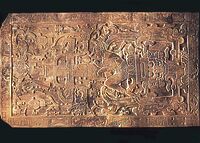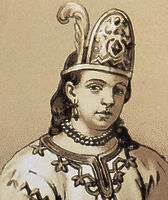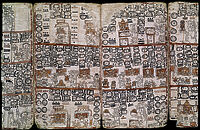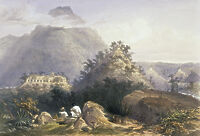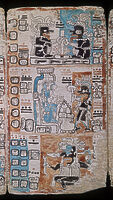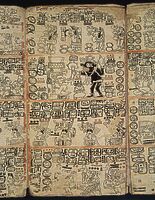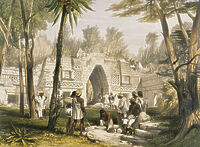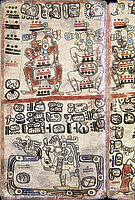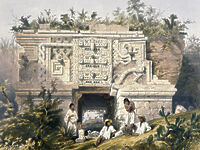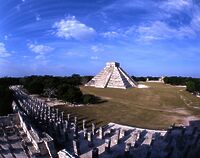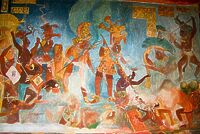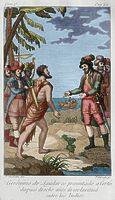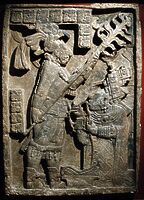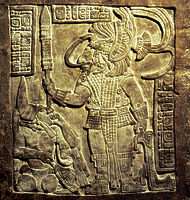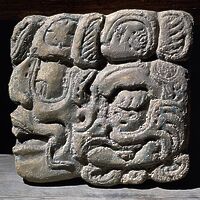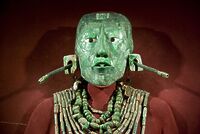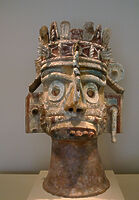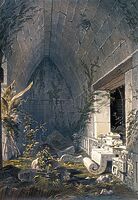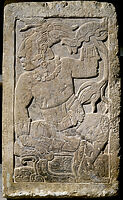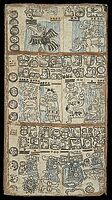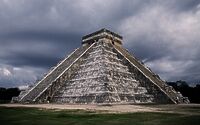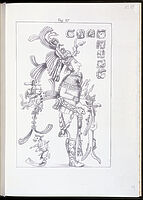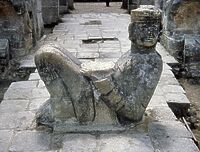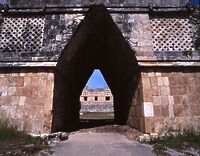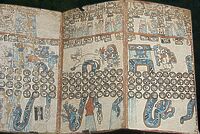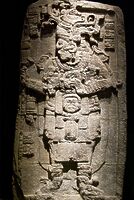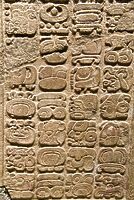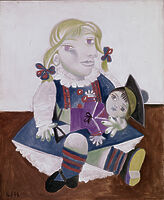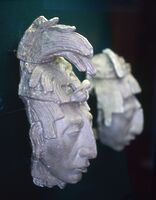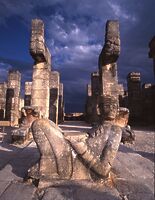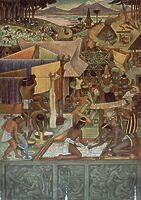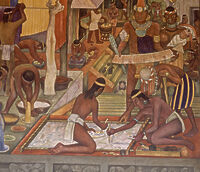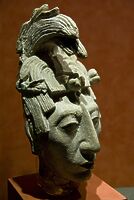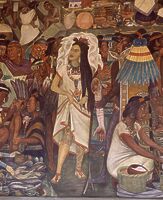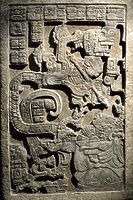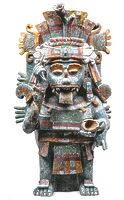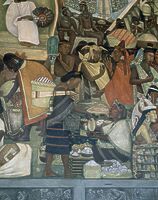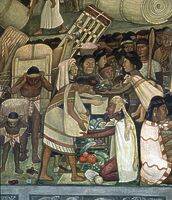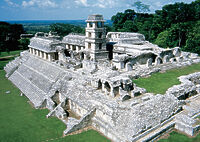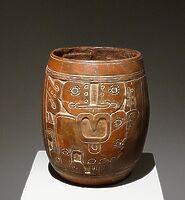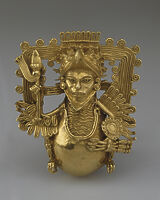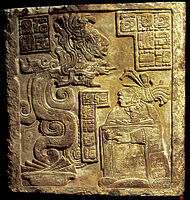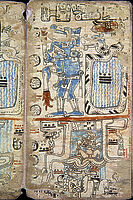Auswahl: Maya-Zivilisation
Maya-Zivilisation
Entdecken Sie Bilder im Zusammenhang mit der Maya-Zivilisation im Album
|
Zu einem anderen Lightbox hinzufügen |
|
Zu einem anderen Lightbox hinzufügen |

|
Zu einem anderen Lightbox hinzufügen |
|
Zu einem anderen Lightbox hinzufügen |

|
Zu einem anderen Lightbox hinzufügen |
|
Zu einem anderen Lightbox hinzufügen |

|
Zu einem anderen Lightbox hinzufügen |
|
Zu einem anderen Lightbox hinzufügen |

|
Zu einem anderen Lightbox hinzufügen |
|
Zu einem anderen Lightbox hinzufügen |

|
Zu einem anderen Lightbox hinzufügen |
|
Zu einem anderen Lightbox hinzufügen |

|
Zu einem anderen Lightbox hinzufügen |
|
Zu einem anderen Lightbox hinzufügen |

|
Zu einem anderen Lightbox hinzufügen |
|
Zu einem anderen Lightbox hinzufügen |

|
Zu einem anderen Lightbox hinzufügen |
|
Zu einem anderen Lightbox hinzufügen |

|
Zu einem anderen Lightbox hinzufügen |
|
Zu einem anderen Lightbox hinzufügen |

|
Zu einem anderen Lightbox hinzufügen |
|
Zu einem anderen Lightbox hinzufügen |

|
Zu einem anderen Lightbox hinzufügen |
|
Zu einem anderen Lightbox hinzufügen |

|
Zu einem anderen Lightbox hinzufügen |
|
Zu einem anderen Lightbox hinzufügen |

|
Zu einem anderen Lightbox hinzufügen |
|
Zu einem anderen Lightbox hinzufügen |

|
Zu einem anderen Lightbox hinzufügen |
|
Zu einem anderen Lightbox hinzufügen |

|
Zu einem anderen Lightbox hinzufügen |
|
Zu einem anderen Lightbox hinzufügen |

|
Zu einem anderen Lightbox hinzufügen |
|
Zu einem anderen Lightbox hinzufügen |

|
Zu einem anderen Lightbox hinzufügen |
|
Zu einem anderen Lightbox hinzufügen |

|
Zu einem anderen Lightbox hinzufügen |
|
Zu einem anderen Lightbox hinzufügen |

|
Zu einem anderen Lightbox hinzufügen |
|
Zu einem anderen Lightbox hinzufügen |

|
Zu einem anderen Lightbox hinzufügen |
|
Zu einem anderen Lightbox hinzufügen |

|
Zu einem anderen Lightbox hinzufügen |
|
Zu einem anderen Lightbox hinzufügen |

|
Zu einem anderen Lightbox hinzufügen |
|
Zu einem anderen Lightbox hinzufügen |

|
Zu einem anderen Lightbox hinzufügen |
|
Zu einem anderen Lightbox hinzufügen |

|
Zu einem anderen Lightbox hinzufügen |
|
Zu einem anderen Lightbox hinzufügen |

|
Zu einem anderen Lightbox hinzufügen |
|
Zu einem anderen Lightbox hinzufügen |

|
Zu einem anderen Lightbox hinzufügen |
|
Zu einem anderen Lightbox hinzufügen |

|
Zu einem anderen Lightbox hinzufügen |
|
Zu einem anderen Lightbox hinzufügen |

|
Zu einem anderen Lightbox hinzufügen |
|
Zu einem anderen Lightbox hinzufügen |

|
Zu einem anderen Lightbox hinzufügen |
|
Zu einem anderen Lightbox hinzufügen |

|
Zu einem anderen Lightbox hinzufügen |
|
Zu einem anderen Lightbox hinzufügen |

|
Zu einem anderen Lightbox hinzufügen |
|
Zu einem anderen Lightbox hinzufügen |

|
Zu einem anderen Lightbox hinzufügen |
|
Zu einem anderen Lightbox hinzufügen |

|
Zu einem anderen Lightbox hinzufügen |
|
Zu einem anderen Lightbox hinzufügen |

|
Zu einem anderen Lightbox hinzufügen |
|
Zu einem anderen Lightbox hinzufügen |

|
Zu einem anderen Lightbox hinzufügen |
|
Zu einem anderen Lightbox hinzufügen |

|
Zu einem anderen Lightbox hinzufügen |
|
Zu einem anderen Lightbox hinzufügen |

|
Zu einem anderen Lightbox hinzufügen |
|
Zu einem anderen Lightbox hinzufügen |

|
Zu einem anderen Lightbox hinzufügen |
|
Zu einem anderen Lightbox hinzufügen |

|
Zu einem anderen Lightbox hinzufügen |
|
Zu einem anderen Lightbox hinzufügen |

|
Zu einem anderen Lightbox hinzufügen |
|
Zu einem anderen Lightbox hinzufügen |

|
Zu einem anderen Lightbox hinzufügen |
|
Zu einem anderen Lightbox hinzufügen |

|
Zu einem anderen Lightbox hinzufügen |
|
Zu einem anderen Lightbox hinzufügen |

|
Zu einem anderen Lightbox hinzufügen |
|
Zu einem anderen Lightbox hinzufügen |

|
Zu einem anderen Lightbox hinzufügen |
|
Zu einem anderen Lightbox hinzufügen |

|
Zu einem anderen Lightbox hinzufügen |
|
Zu einem anderen Lightbox hinzufügen |

|
Zu einem anderen Lightbox hinzufügen |
|
Zu einem anderen Lightbox hinzufügen |

|
Zu einem anderen Lightbox hinzufügen |
|
Zu einem anderen Lightbox hinzufügen |

|
Zu einem anderen Lightbox hinzufügen |
|
Zu einem anderen Lightbox hinzufügen |

|
Zu einem anderen Lightbox hinzufügen |
|
Zu einem anderen Lightbox hinzufügen |

|
Zu einem anderen Lightbox hinzufügen |
|
Zu einem anderen Lightbox hinzufügen |

|
Zu einem anderen Lightbox hinzufügen |
|
Zu einem anderen Lightbox hinzufügen |

|
Zu einem anderen Lightbox hinzufügen |
|
Zu einem anderen Lightbox hinzufügen |

|
Zu einem anderen Lightbox hinzufügen |
|
Zu einem anderen Lightbox hinzufügen |

|
Zu einem anderen Lightbox hinzufügen |
|
Zu einem anderen Lightbox hinzufügen |

|
Zu einem anderen Lightbox hinzufügen |
|
Zu einem anderen Lightbox hinzufügen |

|
Zu einem anderen Lightbox hinzufügen |
|
Zu einem anderen Lightbox hinzufügen |

|
Zu einem anderen Lightbox hinzufügen |
|
Zu einem anderen Lightbox hinzufügen |

|
Zu einem anderen Lightbox hinzufügen |
|
Zu einem anderen Lightbox hinzufügen |

|
Zu einem anderen Lightbox hinzufügen |
|
Zu einem anderen Lightbox hinzufügen |

|
Zu einem anderen Lightbox hinzufügen |
|
Zu einem anderen Lightbox hinzufügen |

|
Zu einem anderen Lightbox hinzufügen |
|
Zu einem anderen Lightbox hinzufügen |

|
Zu einem anderen Lightbox hinzufügen |
|
Zu einem anderen Lightbox hinzufügen |

|
Zu einem anderen Lightbox hinzufügen |
|
Zu einem anderen Lightbox hinzufügen |

|
Zu einem anderen Lightbox hinzufügen |
|
Zu einem anderen Lightbox hinzufügen |

|
Zu einem anderen Lightbox hinzufügen |
|
Zu einem anderen Lightbox hinzufügen |

|
Zu einem anderen Lightbox hinzufügen |
|
Zu einem anderen Lightbox hinzufügen |

|
Zu einem anderen Lightbox hinzufügen |
|
Zu einem anderen Lightbox hinzufügen |

|
Zu einem anderen Lightbox hinzufügen |
|
Zu einem anderen Lightbox hinzufügen |

|
Zu einem anderen Lightbox hinzufügen |
|
Zu einem anderen Lightbox hinzufügen |

|
Zu einem anderen Lightbox hinzufügen |
|
Zu einem anderen Lightbox hinzufügen |

|
Zu einem anderen Lightbox hinzufügen |
|
Zu einem anderen Lightbox hinzufügen |

|
Zu einem anderen Lightbox hinzufügen |
|
Zu einem anderen Lightbox hinzufügen |

|
Zu einem anderen Lightbox hinzufügen |
|
Zu einem anderen Lightbox hinzufügen |

|
Zu einem anderen Lightbox hinzufügen |
|
Zu einem anderen Lightbox hinzufügen |

|
Zu einem anderen Lightbox hinzufügen |
|
Zu einem anderen Lightbox hinzufügen |

|
Zu einem anderen Lightbox hinzufügen |
|
Zu einem anderen Lightbox hinzufügen |

|
Zu einem anderen Lightbox hinzufügen |
|
Zu einem anderen Lightbox hinzufügen |

|
Zu einem anderen Lightbox hinzufügen |
|
Zu einem anderen Lightbox hinzufügen |

|
Zu einem anderen Lightbox hinzufügen |
|
Zu einem anderen Lightbox hinzufügen |

|
Zu einem anderen Lightbox hinzufügen |
|
Zu einem anderen Lightbox hinzufügen |

|
Zu einem anderen Lightbox hinzufügen |
|
Zu einem anderen Lightbox hinzufügen |

|
Zu einem anderen Lightbox hinzufügen |
|
Zu einem anderen Lightbox hinzufügen |

|
Zu einem anderen Lightbox hinzufügen |
|
Zu einem anderen Lightbox hinzufügen |

|
Zu einem anderen Lightbox hinzufügen |
|
Zu einem anderen Lightbox hinzufügen |

|
Zu einem anderen Lightbox hinzufügen |
|
Zu einem anderen Lightbox hinzufügen |

|
Zu einem anderen Lightbox hinzufügen |
|
Zu einem anderen Lightbox hinzufügen |

|
Zu einem anderen Lightbox hinzufügen |
|
Zu einem anderen Lightbox hinzufügen |

|
Zu einem anderen Lightbox hinzufügen |
|
Zu einem anderen Lightbox hinzufügen |

|
Zu einem anderen Lightbox hinzufügen |
|
Zu einem anderen Lightbox hinzufügen |

|
Zu einem anderen Lightbox hinzufügen |
|
Zu einem anderen Lightbox hinzufügen |

|
Zu einem anderen Lightbox hinzufügen |
|
Zu einem anderen Lightbox hinzufügen |

|
Zu einem anderen Lightbox hinzufügen |
|
Zu einem anderen Lightbox hinzufügen |

|
Zu einem anderen Lightbox hinzufügen |
|
Zu einem anderen Lightbox hinzufügen |

|
Zu einem anderen Lightbox hinzufügen |
|
Zu einem anderen Lightbox hinzufügen |

|
Zu einem anderen Lightbox hinzufügen |
|
Zu einem anderen Lightbox hinzufügen |

|
Zu einem anderen Lightbox hinzufügen |
|
Zu einem anderen Lightbox hinzufügen |

|
Zu einem anderen Lightbox hinzufügen |
|
Zu einem anderen Lightbox hinzufügen |

|
Zu einem anderen Lightbox hinzufügen |
|
Zu einem anderen Lightbox hinzufügen |

|
Zu einem anderen Lightbox hinzufügen |
|
Zu einem anderen Lightbox hinzufügen |

|
Zu einem anderen Lightbox hinzufügen |
|
Zu einem anderen Lightbox hinzufügen |

|
Zu einem anderen Lightbox hinzufügen |
|
Zu einem anderen Lightbox hinzufügen |

|
Zu einem anderen Lightbox hinzufügen |
|
Zu einem anderen Lightbox hinzufügen |

|
Zu einem anderen Lightbox hinzufügen |
|
Zu einem anderen Lightbox hinzufügen |

|
Zu einem anderen Lightbox hinzufügen |
|
Zu einem anderen Lightbox hinzufügen |

|
Zu einem anderen Lightbox hinzufügen |
|
Zu einem anderen Lightbox hinzufügen |

|
Zu einem anderen Lightbox hinzufügen |
|
Zu einem anderen Lightbox hinzufügen |

|
Zu einem anderen Lightbox hinzufügen |
|
Zu einem anderen Lightbox hinzufügen |

|
Zu einem anderen Lightbox hinzufügen |
|
Zu einem anderen Lightbox hinzufügen |

|
Zu einem anderen Lightbox hinzufügen |
|
Zu einem anderen Lightbox hinzufügen |

|
Zu einem anderen Lightbox hinzufügen |
|
Zu einem anderen Lightbox hinzufügen |

|
Zu einem anderen Lightbox hinzufügen |
|
Zu einem anderen Lightbox hinzufügen |

|
Zu einem anderen Lightbox hinzufügen |
|
Zu einem anderen Lightbox hinzufügen |

|
Zu einem anderen Lightbox hinzufügen |
|
Zu einem anderen Lightbox hinzufügen |

|
Zu einem anderen Lightbox hinzufügen |
|
Zu einem anderen Lightbox hinzufügen |

|
Zu einem anderen Lightbox hinzufügen |
|
Zu einem anderen Lightbox hinzufügen |

|
Zu einem anderen Lightbox hinzufügen |
|
Zu einem anderen Lightbox hinzufügen |

|
Zu einem anderen Lightbox hinzufügen |
|
Zu einem anderen Lightbox hinzufügen |

|
Zu einem anderen Lightbox hinzufügen |
|
Zu einem anderen Lightbox hinzufügen |

|
Zu einem anderen Lightbox hinzufügen |
|
Zu einem anderen Lightbox hinzufügen |

|
Zu einem anderen Lightbox hinzufügen |
|
Zu einem anderen Lightbox hinzufügen |

|
Zu einem anderen Lightbox hinzufügen |
|
Zu einem anderen Lightbox hinzufügen |

|
Zu einem anderen Lightbox hinzufügen |
|
Zu einem anderen Lightbox hinzufügen |

|
Zu einem anderen Lightbox hinzufügen |
|
Zu einem anderen Lightbox hinzufügen |

|
Zu einem anderen Lightbox hinzufügen |
|
Zu einem anderen Lightbox hinzufügen |

|
Zu einem anderen Lightbox hinzufügen |
|
Zu einem anderen Lightbox hinzufügen |

|
Zu einem anderen Lightbox hinzufügen |
|
Zu einem anderen Lightbox hinzufügen |

|
Zu einem anderen Lightbox hinzufügen |
|
Zu einem anderen Lightbox hinzufügen |

|
Zu einem anderen Lightbox hinzufügen |
|
Zu einem anderen Lightbox hinzufügen |

|
Zu einem anderen Lightbox hinzufügen |
|
Zu einem anderen Lightbox hinzufügen |

|
Zu einem anderen Lightbox hinzufügen |
|
Zu einem anderen Lightbox hinzufügen |

|
Zu einem anderen Lightbox hinzufügen |
|
Zu einem anderen Lightbox hinzufügen |

|
Zu einem anderen Lightbox hinzufügen |
|
Zu einem anderen Lightbox hinzufügen |

|
Zu einem anderen Lightbox hinzufügen |
|
Zu einem anderen Lightbox hinzufügen |

|
Zu einem anderen Lightbox hinzufügen |
|
Zu einem anderen Lightbox hinzufügen |

|
Zu einem anderen Lightbox hinzufügen |
|
Zu einem anderen Lightbox hinzufügen |

|
Zu einem anderen Lightbox hinzufügen |
|
Zu einem anderen Lightbox hinzufügen |

|
Zu einem anderen Lightbox hinzufügen |
|
Zu einem anderen Lightbox hinzufügen |

|
Zu einem anderen Lightbox hinzufügen |
|
Zu einem anderen Lightbox hinzufügen |

|
Zu einem anderen Lightbox hinzufügen |
|
Zu einem anderen Lightbox hinzufügen |

|
Zu einem anderen Lightbox hinzufügen |
|
Zu einem anderen Lightbox hinzufügen |

|
Zu einem anderen Lightbox hinzufügen |
|
Zu einem anderen Lightbox hinzufügen |

|
Zu einem anderen Lightbox hinzufügen |
|
Zu einem anderen Lightbox hinzufügen |

|
Zu einem anderen Lightbox hinzufügen |
|
Zu einem anderen Lightbox hinzufügen |

|
Zu einem anderen Lightbox hinzufügen |
|
Zu einem anderen Lightbox hinzufügen |

|
Zu einem anderen Lightbox hinzufügen |
|
Zu einem anderen Lightbox hinzufügen |

|
Zu einem anderen Lightbox hinzufügen |
|
Zu einem anderen Lightbox hinzufügen |

|
Zu einem anderen Lightbox hinzufügen |
|
Zu einem anderen Lightbox hinzufügen |

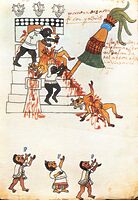

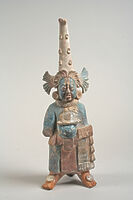
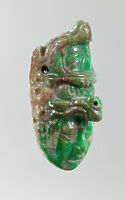
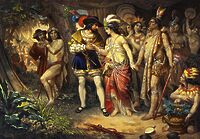

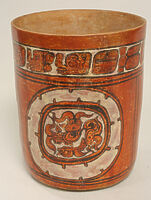
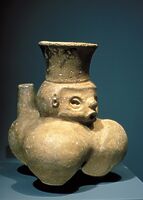
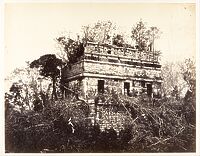
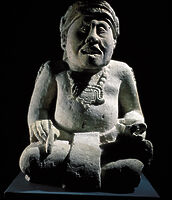
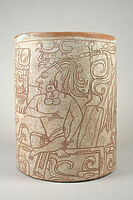
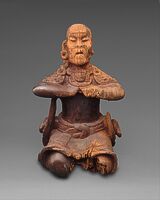
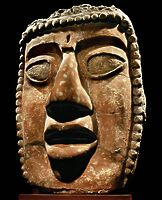
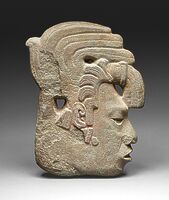
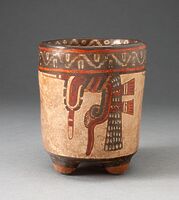
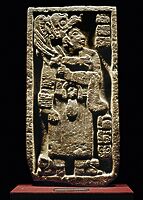
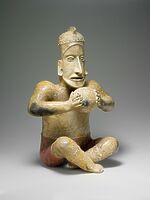
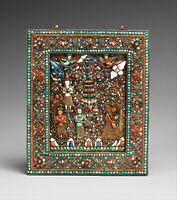

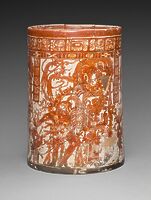
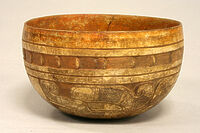

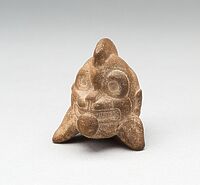
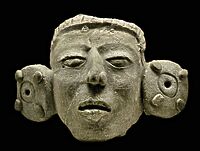
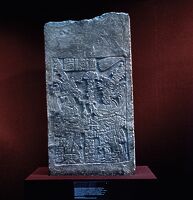
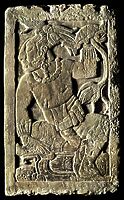
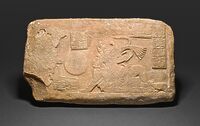
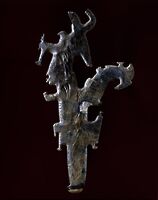
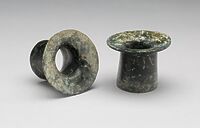
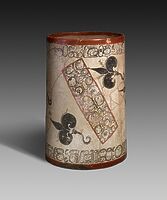
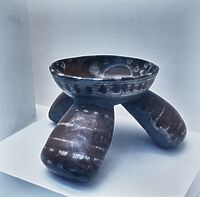
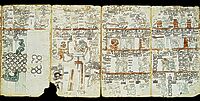
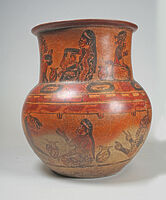
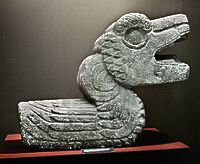
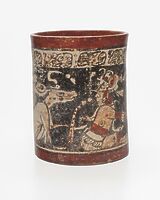
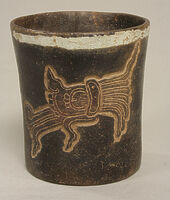
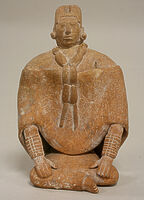
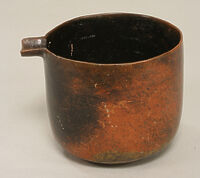
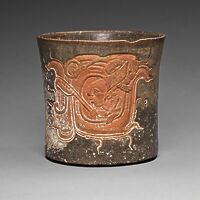
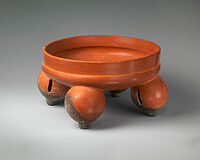
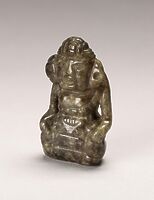
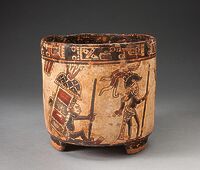
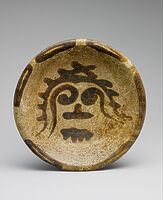
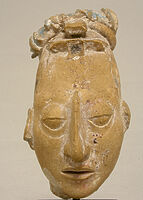
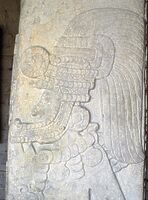
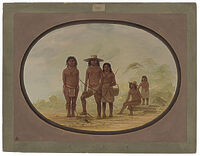
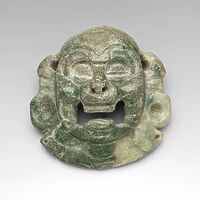
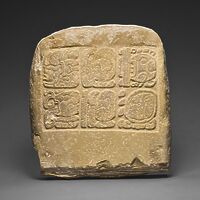
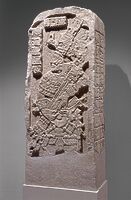
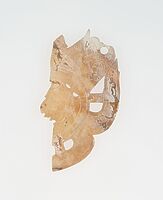
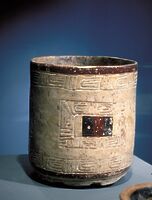
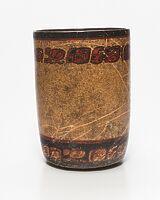
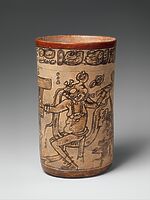
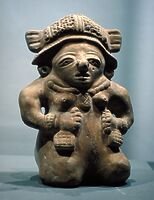
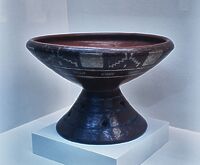
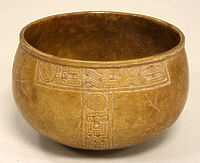

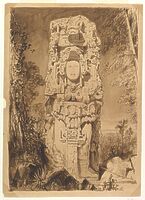
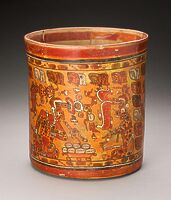
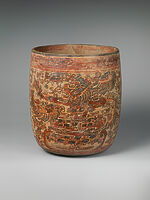
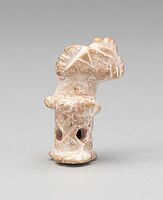
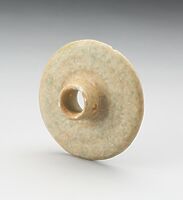
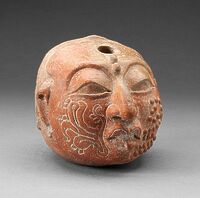
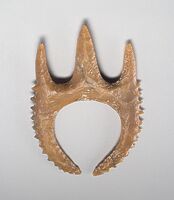
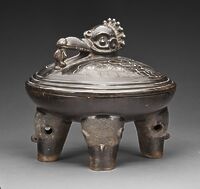
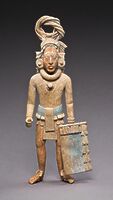
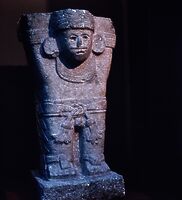
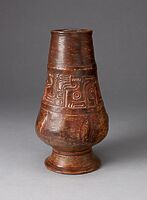
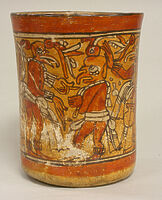
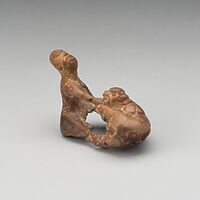
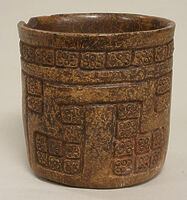
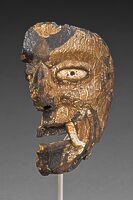
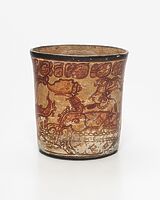
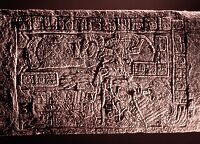
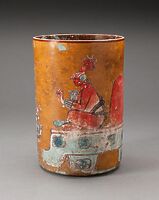
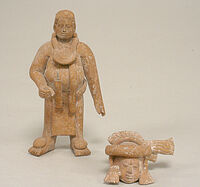
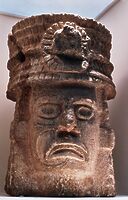
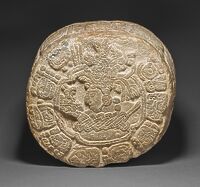
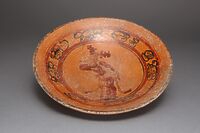
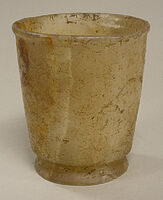
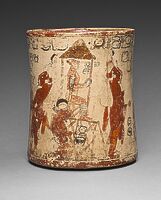
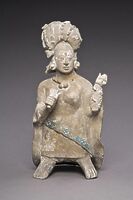
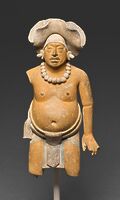
![Deity Face Pendant. Culture: Maya. Dimensions: H. 2 1/4 in. (5.7 cm). Date: 7th-8th century.
This apple-green jade ornament represents the avian face of Ux Yop Hu'n ("Three Leaves Paper" or "Three-Leaf-Paper") a complex supernatural being that personified the paper headband worn by ancient Maya rulers. This figure is also frequently referred to in the literature as "the foliated Jester God." His forehead is infixed with a hieroglyphic sign that translates as ajaw, or ruler (a schematic face comprised of two dots for eyes and one for a mouth). Ux Yop Hu'n is shown cross-eyed, his squared pupils looking inward toward a furrowed brow. In Maya art, this eye is a diagnostic feature of shining, solar, and/or resplendent supernatural beings. Below, a small nose with curling nostrils is carved atop a downturned beak. When seen in profile images, this bird beak has a distinct bracket shape (see, for instance, 1978.412.90a, b). Because jade is so difficult to carve, and because the artist was likely following the contours of a thin vein of apple-green jade, the beak has been flattened down in low relief against the face, overhanging the mouth. Two scrolls are visible on either side of the forehead, above (but separate from) the figure's beaded earflare assemblages. From each of these scrolls descends a curving stem and leaves of vegetation. These vegetal symbols represent amate or fig leaves (ficus, sp.). In the ancient Maya world, amate bark was hammered out into thin sheets to make paper and cloth. When seen in iconography and inscriptions, amate stems and leaves can be read as hu'n, or "paper."
Jade objects like this one are frequently seen in Maya art as the central jewel of rulers' headbands. During accession rituals, the king received the paper headband of rulership, a transformative moment in which he was "wrapped" into the office of kingship, transitioning from human mortal into divine king. That this ornament likely did serve as a central headband jewel is suggested by the two suspension holes and connecting channel that are carved out of its reverse side. These would have been used to affix the ornament to the paper headband. Five tiny holes (two on either side of the face and one at the top of the forehead) were drilled through the edges of the ornament, while five slightly larger L-shaped holes were drilled behind the bird's chin, allowing for the suspension of additional beads or strings of beads. Because this headband jewel is depicted in Maya iconography as a face with three elements projecting from its forehead (much like the tri-point hats worn by court jesters in the western world), this motif was dubbed the "Jester God" during the 1970s. This nickname has remained in use ever since, despite its misleading connotations.
This supernatural face embraces multiple, simultaneous meanings. David Stuart, for instance, has recently demonstrated that this particular foliated version of the Jester God (there are also fish and maize versions) serves as a hieroglyph that can be read as Ux Yop Hu'n ("Three Leaves Paper" or "Three-Leaf-Paper"). In hieroglyphic passages, the sign is reduced to a forehead infixed with an ajaw glyph that sprouts three amate leaves--if the avian face of this ornament were removed, this hieroglyphic sign for paper is what would remain. Although only two stems of vegetation are visible, a third is implied. It may even have been physically recreated by affixing a string of jade beads through the small hole in the top of the bird's forehead. The ornament, then, is self-referential: used as the central jewel of a ruler's amate paper headband, it simply and clearly labels itself and the cloth to which it was once attached as the paper headband of kings.
In addition to its role as a specific hieroglyphic label, this supernatural face should also be seen as the divine embodiment of paper, which was considered an animate substance in the ancient Maya world. In art, for example, this face is found atop books to represent the embodied essence of paper. This ornament, then, not only serves as a label describing the headband of rulers, but should be understood as a personified, animate paper headband in and of itself.
This face also serves as the proper name Ux Yop Hu'n, a mytho-historical "proto-ruler" found in a number of Classic period inscriptions. The potential play between the words juun (one) and hu'n (headband) suggest that these may be equivalent names for the same personage, Juun Ajaw ("First King"), who acceded to office in mythic time. Juun Ajaw was the first ruler to take on the paper headband, thereby setting mythological precedent for future kings. At accession, the wrapping of the paper headband around the forehead of a new Maya ruler would have referenced Juun Ajaw, equating the new king with his mythical predecessor. This jade ornament would have labeled the king who wore it as Ux Yop Hu'n himself, a present iteration of the first, prototypical king.
If one strips away the infixed ajaw forehead and hanging foliage of this ornament, one is left with the face of the Principal Bird Deity, a great supernatural bird associated with wealth and rulership in ancient Maya myth. The Principal Bird Deity served as the embodiment of all things precious, including green growing crops, the iridescent green feathers of the quetzal bird, and life-giving rain. Above all, though, he was envisioned as a great, resplendent avian embodiment of jade. With jade beads strung through the five holes along the edges of this ornament, the face of the Principal Bird Deity would have literally dripped with jade. Additional strings of beads threaded through the tiny holes behind the bird's chin would have given him a jewel-beaded beard, a feature commonly exhibited by the Principal Bird Deity in art (see 1979.206.1069) that associated him with shining drops of rain.
The word "jade," when used in Mesoamerican contexts, refers specifically to jadeite. All Mesoamerican jade comes from a single source, located in the Motagua River Valley of eastern highland Guatemala. Such a restricted point of access made jade a particularly rare and valuable material, an important element in elite trade networks and economic exchange systems in the ancient Maya world. In this world, religious belief and ideology were not separable from matters of economy, so the power of the king derived as much from mythical precedents and divine sanction as it did from the practical realities of agricultural production and economic success. The highly desirable apple-green shade of this jade ornament and its depiction of the Principal Bird Deity therefore proclaimed the ruler's control over systems of economic exchange and access to exotic trade materials. (For more on jade, please see the entry for 1994.35.582.)
The Principal Bird Deity was not just wealth and riches personified, but, much like Ux Yop Hu'n, was simultaneously conceptualized as a mytho-historical figure, a deity associated with the beginnings of kingship and the foundations of human rule. Recent research has demonstrated that the Principal Bird Deity represented one of the great primordial sacrifices in mythic time that gave rise to humankind. Much as the Maize God was believed to have given of his own flesh to create the first humans, the Principal Bird Deity gave his flesh (that of resplendent jade and agricultural riches) to give rise to the first human kings. For more on the Principal Bird Deity (including this great mythical sacrifice), please see the entries for 1979.206.1069 and 1978.412.90a, b.
The two distinct sets of five small holes drilled into this ornament represent a noteworthy detail. In ancient Maya religion, the number five was associated with the four corners and center of the cosmos. The repeated use of five holes thus subtly connected the king who once wore this ornament with the world center. Maya mythic histories tell of the setting up of the world, in which four great trees were raised at the corners of the cosmos, with a fifth marking the center. The Principal Bird Deity appears to have been associated with the raising of these trees, laying out the four-sided world for humankind to occupy. In a similar vein, the forehead of Ux Yop Hu'n is frequently depicted as a tree with three branches, a clear reference to the axis mundi, which was envisioned as a great tree with its roots in the Underworld and branches in the heavens. This jade ornament, then, closely associated its wearer with cosmic origins and the center of the world.
Traces of red pigment, which scientific examination has identified as iron oxide, can be seen in some of the crevices of this ornament. Red pigments, such as iron oxide and cinnabar, were frequently used to paint the bodies of deceased royalty and their belongings, so it is very likely that this headband jewel was found in a royal tomb context. Red pigments were closely linked to blood, while green jade was associated with living breath, new growth, and life. The combination (and juxtaposition) of blood red pigments with bright green jade in the context of a royal tomb was thus highly symbolic, ensuring eternal life for the deceased king and his rebirth into divine realms from the earthly world.
In sum, this small ornament embraces a multitude of layered meanings. First, it is a phonetic hieroglyph for the paper headband of rulers. Second, it represents the face of embodied paper. Third, and more specifically, it is the personification of the headband of rulers, which was used during accession rites to transform human mortals into divine kings. Fourth, it represents the proper name of the first prototypical Maya king, linking the ruler who wore it to mythical precedent and labeling him as the present incarnation of this first primordial king. These references are simultaneously underpinned with allusions to jade, wealth, preciousness, and agricultural success. The face of the Principal Bird Deity acts as a kind of shorthand meant to connect the ruler wearing this headband jewel to one of the great primordial sacrifices that, by bestowing earthly riches upon the first human kings, thereby gave to them the divine right to rule. Finally, this ornament located its wearer at the center of the world, connecting him with the deep, mythical origins of the cosmos, when the four sides of the world were established and the great world tree was raised to mark its center.
-Lucia R. Henderson, Pamela and Sylvan C. Coleman Fellow, 2015
Cited Sources and Additional Reading
Christie's Auction House. 2005. Art Africain, Oceanien et Precolombien. 6 Dec. 2005, Paris. See Lot 428, p.164 for a published image of the ornament.
Fields, Virginia M. "The Iconographic Heritage of the Maya Jester God." In Sixth Palenque Round Table, 1986, edited by Merle Greene Robertson, 167-74. Norman: University of Oklahoma Press, 1991.
Fields, Virginia M. The Origins of Divine Kingship among the Lowland Classic Maya. Doctoral Dissertation, Department of Art and Art History, University of Texas at Austin, 1989.
Freidel, David A. "The Jester God. The Beginning and End of a Maya Royal Symbol." In Vision and Revision in Maya Studies, edited by Flora S. Clancy and Peter D. Harrison, 67-78. Albuquerque: University of New Mexico Press, 1990.
Freidel, David A., and Linda Schele. "Kingship in the Late Preclassic Maya Lowlands: The Instruments and Places of Ritual Power." American Anthropologist 90, no. 3 (1988): 447-567.
Freidel, David A., Linda Schele, and Joy Parker. Maya Cosmos: Three Thousand Years on the Shaman's Path. New York: William Morrow, 1993.
Grube, Nikolai. "The Insignia of Power." In Maya: Divine Kings of the Rain Forest, edited by Nikolai Grube, 96-97. Cologne: Könemann, 2006.
Guernsey, Julia. "Signifying Late Preclassic Rulership: Patterns of Continuity from the Southern Maya Zone." In The Southern Maya in the Late Preclassic: The Rise and Fall of an Early Mesoamerican Civilization, edited by Michael Love and Jonathan H. Kaplan, 115-38. Boulder: University Press of Colorado, 2011.
Guernsey, Julia, and F. Kent Reilly, eds. Sacred Bundles: Ritual Acts of Wrapping and Binding in Mesoamerica, Ancient America Special Publication Number One. Barnardsville: Boundary End Archaeological Research Center, 2006.
Henderson, Lucia R. Bodies Politic, Bodies in Stone: Imagery of the Human and the Divine in the Sculpture of Late Preclassic Kaminaljuyú, Guatemala. Doctoral Dissertation, Department of Art and Art History, University of Texas at Austin, 2013. See especially pp. 333-391.
Miller, Mary Ellen, and Simon Martin. Courtly Art of the Ancient Maya. San Francisco and New York: Fine Arts Museums of San Francisco and Thames & Hudson, 2004. See especially Cat. 22, 23, and 25.
Pillsbury, Joanne, Miriam Doutriaux, Reiko Ishihara-Brito, and Alexandre Tokovinine, eds. Ancient Maya Art at Dumbarton Oaks, Pre-Columbian Art at Dumbarton Oaks, No. 4. Washington, D.C.: Dumbarton Oaks Research Library and Collection, 2012. See especially pp. 146-150.
Reilly, F. Kent. "Olmec Ideological, Ritual, and Symbolic Contributions to the Institution of Classic Maya Kingship." In Lords of Creation: The Origins of Sacred Maya Kingship, edited by Virginia M. Fields and Dorie Reents-Budet, 30-36. Los Angeles: Los Angeles County Museum of Art, 2005.
Saturno, William A., Karl A. Taube, David Stuart, and Heather Hurst. The Murals of San Bartolo, El Petén, Guatemala. Part 1, the North Wall. Ancient America, No. 7. Barnardsville: Center for Ancient American Studies, 2005. See especially pp. 25-31.
Schele, Linda. "Observations on the Cross Motif at Palenque." In Primera Mesa Redonda de Palenque: A Conference on the Art, Iconography, and Dynastic History of Palenque, edited by Merle Greene Robertson, 41-62. Pebble Beach: Robert Louis Stevenson School, Pre-Columbian Art Research, 1974. See especially p. 42.
Schele, Linda. "Genealogical Documentation on the Tri-Figure Panels at Palenque." In Proceedings of the Tercera Mesa Redonda De Palenque. Third Palenque Round Table, edited by Merle Greene Robertson and Donnan Call Jeffers, 41-70. Austin: University of Texas Press, 1978. See especially pp. 47-49.
Schele, Linda, and David A. Freidel. A Forest of Kings: The Untold Story of the Ancient Maya. New York: Morrow, 1990.
Schele, Linda, and Mary Ellen Miller. The Blood of Kings: Dynasty and Ritual in Maya Art. New York and Fort Worth: G. Braziller and the Kimbell Art Museum, 1986. See especially pp.79, 83, 111-120, pl.11 and pl. 23.
Stuart, David. "Kings of Stone: A Consideration of Stelae in Ancient Maya Ritual and Representation." Res 29-30 (1996): 148-71.
Stuart, David. "La concha decorada de la tumba del Templo Del Búho, Dzibanché." In Los cautivos de Dzibanché, edited by Enrique Nalda, 132-40. Mexico: Instituto Nacional de Antropología e Historia, 2004.
Stuart, David. "The Name of Paper: The Mythology of Crowning and Royal Nomenclature on Palenque's Palace Tablet." In Maya Archaeology 2, edited by Charles Golden, Stephen Houston and Joel Skidmore, 118-48. San Francisco: Precolumbia Mesoweb Press, 2012.
Stuart, David. "The Royal Headband: A Pan-Mesoamerican Hieroglyph." In https://decipherment.wordpress.com, 2015 [2008].
Taube, Karl A. "The Jade Hearth: Centrality, Rulership, and the Classic Maya Temple." In Function and Meaning in Classic Maya Architecture, edited by Stephen Houston, 427-79. Washington, D.C.: Dumbarton oaks Research Library and Collection, 1998.
Taube, Karl A. "The Symbolism of Jade in Classic Maya Religion." Ancient Mesoamerica 16 (2005): 23-50.
Taube, Karl A., William A. Saturno, David Stuart, and Heather Hurst. The Murals of San Bartolo, El Petén, Guatemala; Part 2: The West Wall. Ancient America, No. 10. Barnardsville: Boundary End Archaeological Research Center, 2010. See especially pp. 65-69.](/photos/lo/OWEwMGQ5MA/album_alb3645972.jpg)
